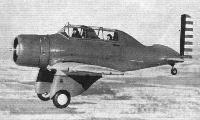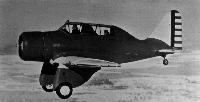
Варианты
- Seversky - SEV-3 - 1933 - США
- Seversky - SEV-2XP / BT-8 - 1934 - США
Seversky SEV-2XP
В инициативном порядке фирма "Seversky" спроектировала прототип двухместного истребителя SEV-2XP. В ходе оценочных испытаний, проводимых Армией США в июне 1935 года, прототип получил повреждения, после которых ему требовался ремонт.
Главный конструктор фирмы Александр Картвелишвили предложил переделать самолет в одноместный, а шасси сделать убираемым. В новом облике самолет получил обозначение SEV-1XP.
Описание:
- Seversky SEV-2XP
- Seversky BT-8
Фотографии
-
Aeroplane Monthly 1993-12 / H.Levy - Seversky (1)
Регистрационный номер: X2106 De Seversky extended the nose of the prototype and enlarged the canopy, making it the demonstration prototype for a basic trainer competition which it won, being produced as the BT-8.
-
Air International 1992-10 / Fighter A to Z
Регистрационный номер: X18Y [3] The two-seat SEV-2XP was the first of the Seversky fighters, derived by Alexander Kartveli from the commercial SEV-3.
-
Мировая Авиация 232
Регистрационный номер: X18Y [3] Чрезвычайно компактный SEV-2XP с максимальной взлетной массой в 1837 кг послужил отправной точкой при инициативном проектировании прототипа истребителя P-35 и учебного BT-8.
-
Aeroplane Monthly 1993-12 / H.Levy - Seversky (1)
Регистрационный номер: X18Y [3] The 2XP, apparently another development of the prototype 3XAR, appeared about 1935 for a USAAC pursuit/observation aircraft competition. It had a 1,000 h.p. Wright Cyclone and carried two in tandem.
-
Мировая Авиация 232
Все BT-8 построили и сдали заказчику в 1938 году. Для мотора воздушного охлаждения Pratt & Whitney R-985-11 Wasp Junior мощностью 450 л. с. самолет BT-8 был тяжеловат.
-
Aeroplane Monthly 1993-12 / H.Levy - Seversky (1)
During 1936 and 1937 the USAAC took delivery of 30 BT-8s, plus five as spares. The engine was the 350 h.p. Wright R-975-E.
-
Flight 1936-06 / Flight
One of the new 176 m.p.h. Whirlwind-engined Seversky "basic trainer" monoplanes for the U.S. Army Air Corps. We should know it as an advanced trainer.
-
Jane's All the World Aircraft 1938 / 03 - All the world's aeroplanes
The Seversky BT-8 Two-seat Basic Trainer Monoplane (350 h.p. Wright R-975E engine).
-
Flight 1936-08 / Flight
Four Seversky models gathered together at Farmingdale, Long Island, U.S.A., illustrate the persistence of the family likeness. From left to right are the new amphibian two-seater fighter (three of these have already been delivered to the Colombian Government); a landplane version of the machine on which Major de Seversky, its designer, established the world's amphibian speed record with 230.03 m.p.h.; the 1,000 h.p. Twin-Wasp-powered fighter ordered in quantity by the U.S. Army Air Corps; and the basic trainer for the same service.
Другие самолёты на фотографии: Seversky P-35 - США - 1936Seversky SEV-3 - США - 1933
-
Aeroplane Monthly 1993-12 / H.Levy - Seversky (1)
The BT-8 Special was a one-off modified BT-8 with a P-35 empennage and increased-span wings with dihedral. It lost to the North American BT-9 in the basic trainer competition.
-
Aeroplane Monthly 1993-12 / H.Levy - Seversky (1)
The X-BT was proposed as a basic trainer but could also be configured for advanced training or combat. As a basic trainer it had long-span (41ft) wings and fixed undercarriage; 36ft-span wings and retractable undercarriage were fitted for the advanced trainer/fighter role. The engine was a 550 h.p. Pratt & Whitney Wasp.
- Фотографии










